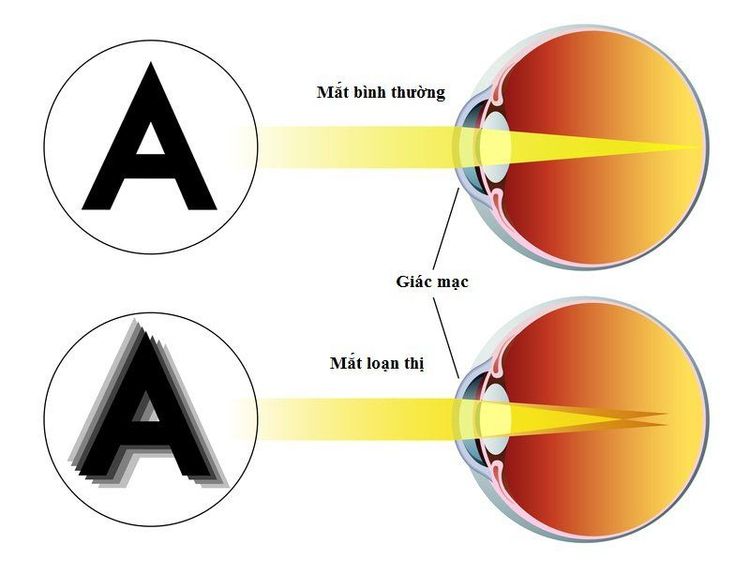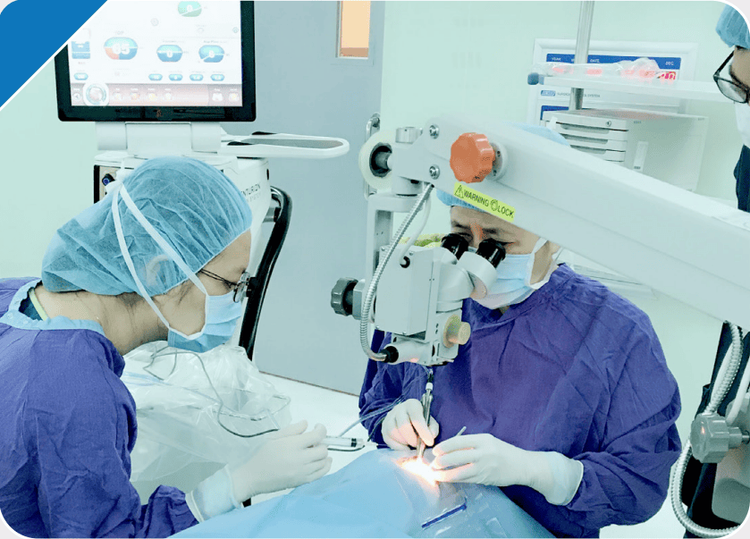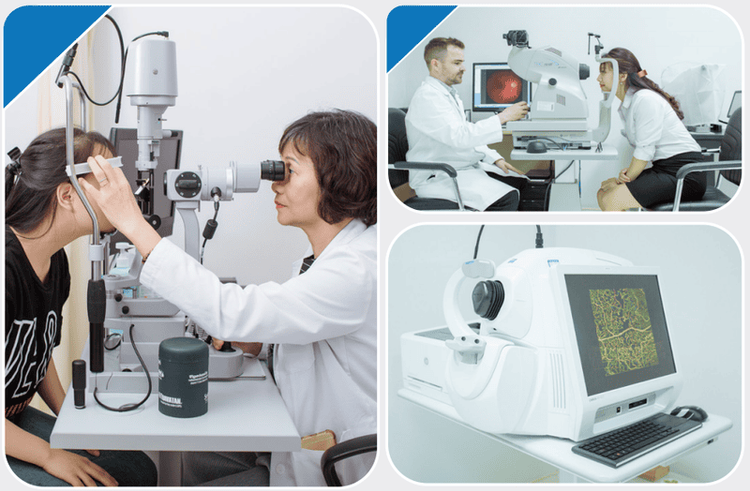This is an automatically translated article.
The article was professionally consulted by an eye doctor - Department of Medical Examination & Internal Medicine - Vinmec Hai Phong International General HospitalStatistical studies show that the incidence of refractive errors is increasing rapidly in Vietnam. In which astigmatism can occur at any age, regardless of children or adults. Astigmatism is inherited, so babies can also have this refractive error.
1. What is astigmatism?
Astigmatism is a common eye refractive error, which occurs when the image that the eye observes when entering the eye cannot focus on the retina, causing the eye to become blurred. Astigmatism is usually the result of a bent or deformed cornea. If the cornea is distorted in any direction, vision will be affected. This can affect us of any age. With recent studies showing that astigmatism can occur in children 5 years old. The cornea is a transparent, cone-shaped part of the eye, located in front of the eyeball, allowing light to enter the eye. When the cornea no longer maintains the perfect curvature, it becomes deformed, causing light rays to enter the eye, focusing at different points (in front or behind the retina) causing astigmatism. Astigmatism can also occur due to abnormal curvature of the lens.
Loạn thị là nhìn hình ảnh không rõ, mờ nhòe dù nhìn gần hay xa
2. Risk factors for astigmatism
Family history of people with astigmatism or eye disorders, especially people with both parents having astigmatism, the risk of that person's astigmatism is very high People with eye damage such as corneal scarring Having a history of eye surgery such as cataract surgery Advanced age is also one of the factors that increase the risk of astigmatism. In fact, the elderly are often at a higher risk of astigmatism than younger people.
Tỷ lệ người cao tuổi mắc bệnh loạn thị cao hơn người trẻ
3. Recognize the symptoms of astigmatism
People with astigmatism often experience the following symptoms:Blurred vision, blurred or distorted vision at all distances; Double vision: Seeing an object with 2 or 3 shadows; Difficulty seeing at all distances, especially when driving at night; Some other accompanying signs: Eye fatigue, watery eyes, headache, neck pain, shoulder pain...
4. Is astigmatism dangerous?
In most cases, astigmatism is usually mild (less than 1D) without affecting visual function and usually does not require treatment intervention. More severe cases of astigmatism (1D or more) can cause discomfort, headaches, and blurred vision. Astigmatism on 2D or astigmatism in one eye, if not detected and treated early, can lead to very dangerous amblyopia (a condition in which the eye cannot see clearly even with glasses corrected). Therefore, cases of astigmatism should be detected early and treated in the direction of amblyopia to limit visual impairment.
Loạn thị gây khó chịu, đau đầu và nhìn mờ
5. Will astigmatism go away on its own?
When reaching adulthood (about 25 years old), the human body no longer develops so the eyeball no longer changes in size and shape. Thus, at this age, the mismatch between the axial length of the eyeball and the refractive power of the eye does not change, that is, the refractive error at this age will not change anymore.Some people think that mild astigmatism can go away on its own. However, in practice, mild astigmatism usually does not affect visual function and usually does not require treatment intervention. If by the age of 25, the astigmatism is still mild, the patient's vision is still guaranteed.
6. What are the methods of treating astigmatism?
In mild cases, astigmatism may not require treatment, but if it is severe, it is necessary to apply treatment measures to avoid severe progression or cause amblyopia. Common treatments include:Glasses: Most astigmatism can be corrected by wearing prescription glasses. This is a simple measure, widely applied, highly effective, with few complications

Ngoài việc lựa chọn sử dụng kính thuốc thì người loạn thị có thể chọn phương pháp phẫu thuật
7. Where is the prestigious astigmatism examination?

Điều trị và phẫu thuật mắt với các kỹ thuật nhãn khoa chất lượng cao, chuyên sâu mang lại sự hiệu quả, an tâm cho khách hàng
Vinmec Times City Eye Specialist has comprehensive eye and vision care functions for children, adults and the elderly including: refractive error check, laser treatment and surgery. In addition, the department also has the task of coordinating with other clinical departments in the treatment of pathological complications and eye injuries caused by accidents.
The experienced team of Ophthalmologists at Vinmec Times City International Hospital has implemented many types of surgery from routine to difficult surgery, especially techniques that require aesthetics. With enthusiasm and love for the profession, the team of doctors working at Vinmec Times City always gives customers the best services with the highest service quality.

Đội ngũ nhân sự quy tụ các chuyên gia dày dặn kinh nghiệm trong khám, tư vấn, điều trị, phẫu thuật nhãn khoa
The list of doctors with Ophthalmology expertise here includes:
Dr. Raicel Palma Vecino: Completed the residency program in Cuba, with more than 09 years of experience in ophthalmology and used to work. in many countries such as Cuba, Venezuela; Assoc. Dr. Hoang Thi Minh Chau: With more than 39 years of experience in ophthalmology, former Deputy Director of the National Eye Hospital, former head of the corneal conjunctiva department of the Central Eye Hospital and currently working at the Interspecialty Department of Ophthalmology. Vinmec Times City International General Institute; Assoc. Dr. BS. Pham Thi Khanh Van: With more than 37 years of experience in ophthalmology, former head of Corneal Department of Central Eye Hospital, Professional Advisor at the Department of Ophthalmology at Hanoi Medical University. Currently, Dr. Van is working at the Eye Unit, Inter-specialty Department of Vinmec Times City International Hospital; BSCKI. Le Thi Phuong Thao: with more than 6 years of experience in ophthalmic treatment. BS. Thao graduated as a General Doctor at the Moscow Medical Academy named after Sechenov, Russian Federation (2002 - 2009), graduated from the I Ophthalmology Department at Hanoi Medical University, participated in many training courses in ophthalmology. and is a member of Vietnam Ophthalmology Association, Hanoi Ophthalmology Association; Assoc. Dr. Dao Thi Lam Huong: With more than 34 years of experience in the treatment of eye diseases, former head of the Glaucoma Department of Central Eye Hospital and currently working at the Interspecialty Department of Vinmec Times City International Hospital.
Please dial HOTLINE for more information or register for an appointment HERE. Download MyVinmec app to make appointments faster and to manage your bookings easily.













